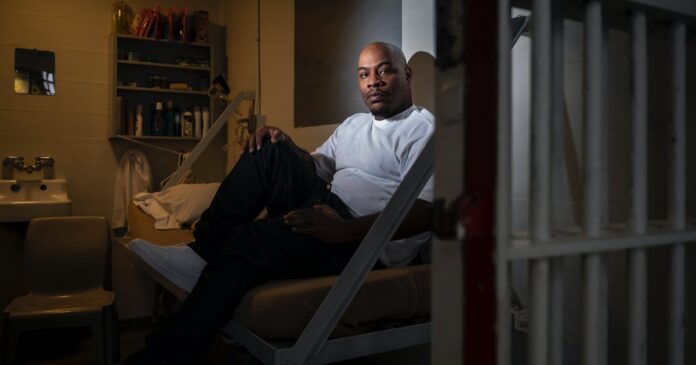Marvin Haynes always maintained his innocence, denying any role in the deadly 2004 flower shop robbery that sent him away for life when he was a teenager.
But after nearly two decades behind bars, he has another chance at freedom.
Attorneys from the Great North Innocence Project argued in Hennepin County District Court Monday that Haynes was wrongfully convicted based on faulty eyewitness identification and improper police lineups — conducted in a way that unsettled even the lead detective.
No physical evidence ever linked Haynes to the fatal shooting of 55-year-old shop clerk Randy Sherer in north Minneapolis. Haynes, then 16, did not match the physical description eyewitnesses provided to investigators. And several witnesses who testified at his trial have since signed affidavits recanting their statements.
“Based on all this evidence, we are confident that following this evidentiary hearing, the court will have ample basis to conclude that Mr. Haynes conviction is legally and factually defective and should therefore be vacated,” Innocence Project attorney Andrew Markquart said during brief opening remarks before Judge William Koch.
The road to an exoneration in this case is an uphill climb for the defense, which is meeting resistance from current and former members of the Hennepin County Attorney’s Office. Former prosecutor Mike Furnstahl told the Star Tribune in March that he stands by the conviction and is “110% confident” in Haynes’ guilt. He cited key testimony by several teenagers, including Haynes’ own cousin, who reported Haynes making incriminating statements before and after the murder.
On Monday, Assistant Hennepin County Attorney Anna Light reminded the court that a jury found Haynes guilty of first-degree murder in 2005 after a thorough reading of the evidence.
“That determination of guilt cannot be set aside lightly,” she said.
Scant evidence
On May 16, 2004, siblings Randy Sherer and Cynthia McDermid were working at Jerry’s Flower Shop at North 33rd and Lyndale Avenues when a young man walked in saying he wanted flowers for his mother. McDermid began to prepare a bouquet.
She soon stared up into the barrel of a silver revolver. The man barked orders demanding money and the security tapes. Sherer emerged from the back, saying there was no money to take. When the robber aimed the gun at her brother, McDermid fled. Two gunshots rung out.
McDermid — the sole eye witness to the crime — described the shooter to police as a 19 to 22 year old Black male, thin build, medium or dark-skinned, nearly six feet tall, 180 pounds, with “close-cropped” hair. There was no forensic evidence from the scene, no video surveillance or viable fingerprints. The weapon was never found.
Police showed McDermid an initial photo lineup that didn’t include Haynes. With 75% to 80% certainty, she chose a man who matched her description but had an alibi.
Two days after the murder, then-Minneapolis police Sgt. Michael Keefe got an anonymous tip that the shooter was “Little Marvin.”
Police soon arrested Marvin Haynes, then 16, for missing a court appearance for violating curfew. His booking photo shows him with a long afro and thin mustache. He was 5 feet 7 inches tall and 130 pounds.
Investigators presented McDermid with another photo lineup. But instead of using Haynes’ mugshot with the longer hair taken hours earlier, they substituted a two-year-old photo of him with short, close-cropped hair. She ultimately pinned him as the shooter.
Detectives then arranged an in-person lineup, where five young men — different from those in the photo lineup — acted as fillers. Haynes was the only person in both.
Both McDermid and a local middle schooler, who claimed to have seen a slender Black male flee from the flower shop following a gunshot that day, each chose Haynes, with varying degrees of confidence.
But the way MPD conducted the suspect lineups violated longstanding best practices by repeatedly exposing witnesses to the same person and using an out-of-date mugshot of Haynes, said Nancy Steblay, a retired professor emeritus of psychology at Augsburg University.
“These are very poor lineups,” Steblay testified Monday. “And the elements are such that this suggests high-risk for identification error, extremely high risk.”
The fact that McDermid initially picked a innocent person — whose physical appearance greatly differed from that of Haynes — also cast doubt on her reliability as a witness, said Steblay, who was commissioned to review Haynes’ case for the Innocence Project.
Memory is malleable, she wrote in her report, with mistaken eyewitness identification faulted for nearly 80% of wrongful convictions in the first 200 cases overturned by DNA evidence.
Keefe, one of the original detectives on the case, also testified Monday that presenting Haynes to the eyewitnesses multiple times was “reckless and irresponsible.”
He recalled that, when a supervisor ordered him to conduct a second lineup with Haynes as the main suspect, he thought it was a joke and questioned the legality. Despite a contentious debate with command staff, Keefe was overruled; Senior Hennepin County attorneys approved the maneuver.
In his experience, eyewitnesses who are confident about their suspect identification often slam their fingers down on the perpetrators’ image and say ‘this is the guy!” Keefe testified. “Cynthia just couldn’t do that.”
McDermid died in 2020.
Looking back, the detective said a “slow and methodical” investigation would have been more proper than using the “hurry up” secondary lineup tactic. But he soon fell ill with cancer and was unable to testify at the original trial.
Doubts about Haynes’ guilt lingered for years, even after his retirement. Under questioning from the defense, Keefe acknowledged that Haynes’ case is the only one, among hundreds he’d worked to secure convictions on, that left him feeling unsettled.
Late last year, the Innocence Project submitted the Haynes case to the Minnesota Attorney General Office’s Conviction Review Unit. Judge Koch agreed to grant the defense an a multi-day evidentiary hearing this week.
Testimony continues Tuesday morning, where Haynes is expected to take the stand.
Staff writer Susan Du contributed to this report.



